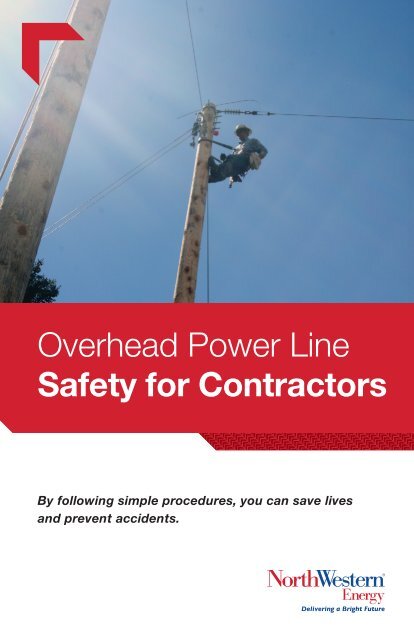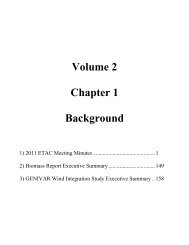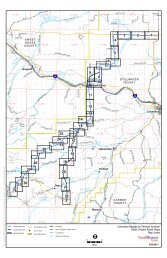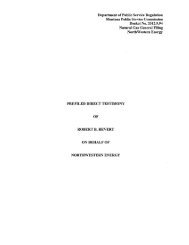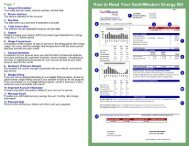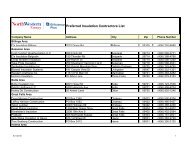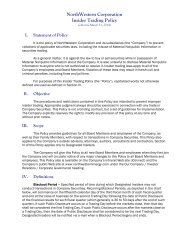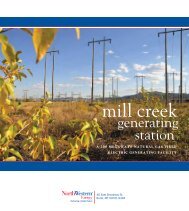Safety for Contractors
Here - NorthWestern Energy
Here - NorthWestern Energy
- No tags were found...
Create successful ePaper yourself
Turn your PDF publications into a flip-book with our unique Google optimized e-Paper software.
Overhead Power Line<br />
<strong>Safety</strong> <strong>for</strong> <strong>Contractors</strong><br />
By following simple procedures, you can save lives<br />
and prevent accidents.
Working Safely<br />
As a contractor, be<strong>for</strong>e you can even<br />
break ground on a construction project,<br />
you have a lot of up-front work to<br />
accomplish. This booklet provides<br />
in<strong>for</strong>mation that will assist you in your<br />
job planning and construction phases,<br />
along with in<strong>for</strong>mation about safety<br />
precautions, on-site supervision,<br />
safe monitoring of heavy equipment<br />
operators, and crane operations.<br />
NorthWestern Energy is willing to be<br />
your partner when it comes to working<br />
safely around utility installations near<br />
your construction project – whether they<br />
are electric, natural gas, or propane.<br />
Working together, we can save lives and<br />
prevent accidents.<br />
Overhead Utilities<br />
Blinding sunlight struck Jim’s eyes as<br />
he surveyed the project site. Only a<br />
few power lines were overhead. Easily<br />
avoidable, thought Jim, as his crew<br />
began to gather around. “It’s going to<br />
be a nice day,” said one workman, as<br />
the crane slowly moved into place, its<br />
boom swinging too high and far to the<br />
right. “Hey, watch the boom!” yelled<br />
Jim, waving his hands at the crane<br />
operator. Startled, the crane operator<br />
strained to hear him over the engine’s<br />
drone. “What?” Then he saw it, just<br />
be<strong>for</strong>e the boom struck the lines.<br />
Sparks flew as the operator jumped<br />
from the cab to the ground. Everyone<br />
scattered. “Watch it, the area’s<br />
2
energized with electricity,” shouted Jim,<br />
warning his crew. That’s when Jim saw<br />
his crane operator on the ground. “He’s<br />
hurt,” shouted a co-worker.<br />
What could have been done to<br />
prevent this accident?<br />
Electrical contacts are among the most<br />
frequently repeated of all construction<br />
accidents, and many involve equipment<br />
contacting overhead electrical power<br />
lines, such as cranes. In fact, power<br />
line contact is the largest single cause<br />
of fatalities associated with cranes. If<br />
correct safety procedures are actively<br />
practiced, these incidents can be<br />
avoided.<br />
When working near any overhead<br />
power line, keep a 10-foot circle of<br />
safety between you, your equipment,<br />
and the line. Practice the 10-foot safety,<br />
rule and be safe. For crane operations<br />
reference the Crane Procedures section<br />
of this pamphlet.<br />
When operating any type of high-lift or<br />
heavy equipment near power lines, or<br />
electrical equipment, it is important to<br />
exercise extreme caution and adhere<br />
to safe equipment operation guidelines.<br />
Do not allow any part of machinery or<br />
equipment to come within the allowable<br />
approach distance of power lines (see<br />
chart on panel inside booklet). Not<br />
only does that violate the Occupational<br />
<strong>Safety</strong> and Health Administration<br />
(OSHA) rule, section 1926.600, but it<br />
also is dangerous <strong>for</strong> the operator and<br />
other employees in the area.<br />
3
<strong>Safety</strong> Considerations<br />
Electricity will flow through any metal<br />
or other conducting material touching<br />
energized lines, even wood. When<br />
machinery, equipment, or materials contact<br />
electrical lines, all conductive parts become<br />
energized and are dangerous.<br />
Electric lines can break or burn, in two,<br />
causing the energized line to fall onto<br />
communication wires, fences, or other<br />
objects. These, in turn, may become<br />
energized and dangerous.<br />
Only trained personnel using special<br />
tools and personal protective equipment<br />
(PPE) can work around high voltage.<br />
These tools and equipment are regularly<br />
maintained, tested, and inspected.<br />
Please notify us of any incident involving<br />
contact with an energized NorthWestern<br />
Energy power line so we may inspect<br />
the site, make the appropriate repairs,<br />
and avoid future problems or damage.<br />
Other local utilities or government<br />
agencies may also need to be notified.<br />
If contact occurs, completely inspect<br />
the machine <strong>for</strong> possible damage. Wire<br />
rope should be replaced if it touches<br />
a power line since the arc is usually of<br />
sufficient high temperature to either<br />
weld or badly damage the wires.<br />
Pre-Job Planning<br />
During the pre-job planning phase<br />
– after your first site survey is made –<br />
plans should be developed <strong>for</strong> working<br />
around any energized electric lines.<br />
Overhead power lines can be a hazard<br />
in any construction project, whenever<br />
any conductive objects are raised into<br />
the air, such as when guying towers or<br />
structures, moving houses, installing<br />
TV antennas, constructing a scaffold or<br />
tower, or operating cranes and high-lift<br />
equipment. Take care of any safety<br />
concerns prior to the start of work or<br />
the arrival of any heavy equipment to<br />
prevent accidents and avoid job delays.<br />
Don’t take chances with your safety.<br />
4
<strong>Safety</strong> Precautions<br />
• Post warning signs prominently on<br />
all cranes or high lift equipment to<br />
effectively keep job personnel on the<br />
alert <strong>for</strong> accidental electrical contact<br />
and what to do in an emergency.<br />
• Do not stockpile, load, or unload any<br />
material near, underneath power lines.<br />
• Do not locate access roads or ramps<br />
near, underneath power lines.<br />
• Treat all power lines as energized until<br />
confirmed by a utility employee they<br />
are de-energized.<br />
• Exercise caution when working near<br />
overhead lines that have long spans<br />
between poles. Wind can make them<br />
swing laterally. Ice buildup causes<br />
sagging.<br />
Site Supervision<br />
When power lines are present near the<br />
work area, the person in charge of the<br />
job site is responsible <strong>for</strong> the safety<br />
of the general public, equipment, and<br />
personnel. <strong>Contractors</strong> should establish<br />
and en<strong>for</strong>ce the following to prevent<br />
contact and accidents:<br />
• Let employees and subcontractors<br />
know the absolute limit of approach –<br />
the area surrounding every energized<br />
electrical power line.<br />
• Choose operating locations to maintain<br />
maximize clearances from power lines.<br />
• Do not, under any circumstances,<br />
move any crane boom, high-lift<br />
equipment, or load line into this area.<br />
All commercial-cage type boom<br />
guards, insulating links, and proximity<br />
warning devices have limitations;<br />
utilize these devices with extreme<br />
caution.<br />
5
General Equipment<br />
For all equipment (except cranes) the<br />
following clearances need to be in place<br />
<strong>for</strong> “unqualified” personnel.<br />
• For voltages to ground 50kV or below<br />
- 10 feet.<br />
• For voltages to ground over 50kV - 10<br />
feet plus 4 inches or every 10kV over<br />
50kV.<br />
Line Voltage<br />
Absolute Limit<br />
of Approach<br />
Up to 50,000 Volts<br />
10 feet<br />
50,001 to 115,000 volts 12 feet<br />
115,001 to 230,000 volts 16 feet<br />
230,001 to 500,000 volts 25 feet<br />
Spotter<br />
A person shall be designated to observe<br />
clearance of equipment and give timely<br />
warning <strong>for</strong> all operations where it is<br />
difficult <strong>for</strong> the operator to maintain the<br />
desired clearance by visual means.<br />
Here are the safety precautions spotters<br />
should adhere to:<br />
• Have no other duties while the<br />
equipment is working near the power<br />
line.<br />
• Position himself or herself<br />
in full view of the operator<br />
and, if using hand signals,<br />
close enough <strong>for</strong> the<br />
signals to be seen clearly.<br />
6<br />
There is no substitute <strong>for</strong> abiding by<br />
the above safety measures.<br />
A good rule of thumb <strong>for</strong> avoiding<br />
contact with the overhead power lines<br />
is to keep a 10-foot circle of safety<br />
between you, your equipment, and the<br />
line. Do not permit any part of your<br />
equipment, or any person working on or<br />
around it, to come within 10-feet of any<br />
power line. Serious injuries could result<br />
to you or others working near you.<br />
If you do come in contact with an<br />
energized line refer to the “If Contact<br />
Occurs” section of this pamphlet.<br />
• Warn the operator when the machine<br />
is approaching the lines because<br />
the operator may not be able to<br />
accurately judge the distance.<br />
elcosh.org
Crane Procedures<br />
Preparing the job site <strong>for</strong> a crane to<br />
work in the area of power lines is<br />
crucial to working safely. The company<br />
controlling or directing the crane<br />
operation must, through their project<br />
engineer, superintendent or <strong>for</strong>eman,<br />
provide a well prepared working area <strong>for</strong><br />
the crane.<br />
The following OSHA regulatory<br />
requirements apply to crane work.<br />
These are the responsibility of the crane<br />
operator employer:<br />
• Per<strong>for</strong>m a hazard assessment be<strong>for</strong>e<br />
beginning equipment operations. The<br />
hazard assessment must identify the<br />
work zone, by either:<br />
o Demarcating boundaries and<br />
prohibiting the operator from<br />
operating equipment past those<br />
boundaries or by<br />
o Defining the work zone as the area<br />
360 degrees around the equipment<br />
up to the equipment’s maximum<br />
working radius.<br />
• Determine if any of the equipment,<br />
load line, or load if operated up to the<br />
maximum working radius could get<br />
closer than following distances to a<br />
power line.<br />
o Up to 350 kV = 20 feet minimum<br />
clearance<br />
o Over 350 kV = 50 feet minimum<br />
clearance<br />
7
If any part of the crane can get closer<br />
than the trigger distance (20/50 ft) one<br />
of the following three options, specified<br />
in the OSHA Crane standard, must be<br />
followed:<br />
• Option 1: Deenergize and ground.<br />
Confirm from the utility owner/<br />
operator that the power line has been<br />
de-energized and visibly grounded at<br />
the work site.<br />
o Crane operator employer needs<br />
to contact the utility operator to<br />
determine if the line can be deenergized.<br />
• Option 2: 20/50 Foot Clearance<br />
– ensure that no part of the load,<br />
load line, or equipment get closer<br />
than 20/50 feet to the power line by<br />
implementing the measures specified<br />
in the OSHA Crane standard.<br />
• Option 3: Table A Clearance – To<br />
use this option, line voltage must be<br />
verified and the measures specified<br />
in the OSHA Crane standard must be<br />
followed.<br />
Here are additional safety preparations<br />
to keep in mind when planning and<br />
conducting crane work:<br />
• Operating locations should be far<br />
enough away from shoring, excavations,<br />
trenches, buried utilities, foundations,<br />
etc. to eliminate risk of collapse.<br />
• Be especially careful when moving the<br />
crane because uneven ground can<br />
cause the boom to weave and swing<br />
into power lines.<br />
• Whenever cranes or large equipment<br />
must repeatedly travel beneath power<br />
lines, a plainly marked route and<br />
erected “rider poles” must accompany<br />
each side of the crossing approach<br />
to ensure the equipment (crane)<br />
structure is lowered to a safe position.<br />
The routes should be located as<br />
close to the power line support tower<br />
or pole as possible in order to take<br />
advantage of the greater ground<br />
clearance.<br />
• Notify the electric utility company<br />
about when and where a crane will be<br />
working near power lines.<br />
• Treat all wires and electrical equipment<br />
as energized until de-energized and<br />
visibly grounded by the electric utility.<br />
• Use a qualified signalman when<br />
required by the OSHA Crane standard.<br />
8<br />
• Make sure there is enough room to<br />
erect and extend the boom away from<br />
overhead power lines.
• Don’t rely on grounded equipment<br />
<strong>for</strong> safety since they provide little or<br />
no protection to personnel on the<br />
ground who may touch the crane.<br />
• Except <strong>for</strong> the operator, keep all<br />
personnel well away from the crane<br />
whenever it is working close to power<br />
lines. Don’t allow anyone standing on<br />
the ground to touch the crane.<br />
• Don’t allow anyone to touch the load, the<br />
crane, or the crane hook until the signal<br />
man indicates that it is safe to do so.<br />
• For further in<strong>for</strong>mation on operating<br />
near power lines contact NorthWestern<br />
Energy at 1-800-245-6977 or visit<br />
www.osha.gov and reference 29<br />
CFR Section 1926.1408-1412 and<br />
1926.600.<br />
Operator Training<br />
Accidents can be avoided if the heavy<br />
equipment operator is trained about<br />
proper safety measures when working<br />
in the vicinity of power lines. Here are<br />
the major training points that should be<br />
covered:<br />
• Provide adequate advance notification<br />
to the local electrical power company.<br />
• Ensure the electric utility is fully<br />
in<strong>for</strong>med about when the operations<br />
are to begin, when they are due to be<br />
completed, and when any location<br />
changes are planned.<br />
• Be<strong>for</strong>e setting up or operating on any<br />
project, always locate the power lines,<br />
assess how they will affect your work and<br />
exercise extreme caution around them.<br />
If Contact Occurs<br />
If equipment contacts power lines and the<br />
machine or its load becomes energized,<br />
follow these safety steps:<br />
• Don’t panic. Advise the operator to<br />
remain in the machine’s cab.<br />
• Don’t move toward the machine to<br />
render aid. Even a slow walk can hurt.<br />
• Keep everyone away from the area.<br />
The machine, the load, and the<br />
ground around it will be energized.<br />
• Call NorthWestern Energy<br />
immediately, using our toll-free<br />
numbers and 911. In Montana call<br />
1-888-467-2353 or in South Dakota<br />
or Nebraska call 1-800-245-6977.<br />
• Call the local utility and 911 if the<br />
contact occurred on a line not owned<br />
by NorthWestern.<br />
• The machine should be moved off and<br />
well away from the power line, if possible.<br />
9
10<br />
• If the machine is not on fire<br />
and cannot be moved away or<br />
disentangled from the line, the<br />
operator should remain inside the<br />
machine until the power company deenergizes<br />
the circuit and confirms that<br />
conditions are safe.<br />
If the operator must leave the machine,<br />
follow these bail-out procedures:<br />
• DO NOT step down from the vehicle!<br />
Under no circumstances should you<br />
step down from the vehicle, allowing<br />
part of your body to be in contact with<br />
the ground while any part is touching<br />
the machine.<br />
• JUMP CLEAR of the machine with<br />
your feet together. Because there<br />
may be hazardous voltage differential<br />
in the ground, you should jump<br />
with both feet together, maintain<br />
balance and shuffle slowly across<br />
the affected area. Do not; under<br />
any circumstances take large steps,<br />
making it possible <strong>for</strong> one foot to be in<br />
a high voltage area and the other foot<br />
to be in a lower voltage area.<br />
• Do not touch any person who is in<br />
contact with energized equipment.<br />
• After the victim has been cleared from<br />
contact with the energized equipment,<br />
administer CPR, if necessary, and<br />
seek immediate medical attention.<br />
Please… take a moment to review<br />
this safety booklet. Put it in a handy<br />
place, such as the glove compartment<br />
of your vehicle or near your telephone.<br />
Notifying<br />
NorthWestern Energy<br />
We want you to avoid contact with<br />
overhead lines so your project can be<br />
accomplished safely. Call us a week in<br />
advance and we will discuss the best way<br />
to proceed with your project so that is can<br />
be done safely and economically. It may<br />
be possible to relocate the line, or de-energize<br />
the line (in some cases).<br />
NorthWestern Energy wants to be your<br />
partner in safety. Call our customer care<br />
center toll free <strong>for</strong> in<strong>for</strong>mation and advice.<br />
In Montana the center is open from 7:00<br />
a.m. to 6:00 p.m., Monday through<br />
Friday and in South Dakota/Nebraska it<br />
is conveniently open 24-hours to assist<br />
you. Of course, emergency calls are taken<br />
24-hours a day and local crews<br />
are dispatched to resolve problems.<br />
In Montana call 1-888-467-2353 or<br />
in South Dakota or Nebraska call<br />
1-800-245-6977. Emergency Services:<br />
911. To request additional copies<br />
of this booklet and/or a free safety<br />
presentation call NorthWestern’s<br />
Resource Center: 1-800-440-2497<br />
Media Contacts: MT – 1-866-622-8081<br />
SD/NE – 1-877-410-0154.
Warning Notice<br />
Please accept this warning notice as an indication of NorthWestern Energy’s commitment<br />
to your safety. Remember: do not permit any part of your equipment, or any<br />
person working on or around it, to come within the minimum approach distance from<br />
any power line. Serious injuries could result to you or others working near you.<br />
If work must be per<strong>for</strong>med within the minimum approach distance from any power line,<br />
contact NorthWestern Energy and obtain assistance be<strong>for</strong>e attempting the work. Our<br />
commitment is to your safety. NorthWestern Energy is pleased to provide this public<br />
safety reminder.<br />
Form No. 1824 Record of Warning is then attached.<br />
Record of Warning<br />
This tag certifies that I have personally presented a Warning Notice to the person named below.<br />
Company Rep.<br />
Company<br />
Company Street Address<br />
Company City, State, Zip<br />
Date of Warning<br />
Time of Warning<br />
AM<br />
PM<br />
Location of Job<br />
Street Address or Description of Location<br />
Nearest City<br />
NWE Division/Area<br />
Type of Equipment<br />
Type of Job<br />
Describe Type of Job in Progress<br />
Signature of NWE Team Member Giving Warning<br />
Team Member’s Job Title<br />
Important Notice: Notify your supervisor immediately after completing this <strong>for</strong>m. Mail all completed <strong>for</strong>ms to the <strong>Safety</strong><br />
Department in Butte, MT.<br />
11
12<br />
NorthWesternEnergy.com


